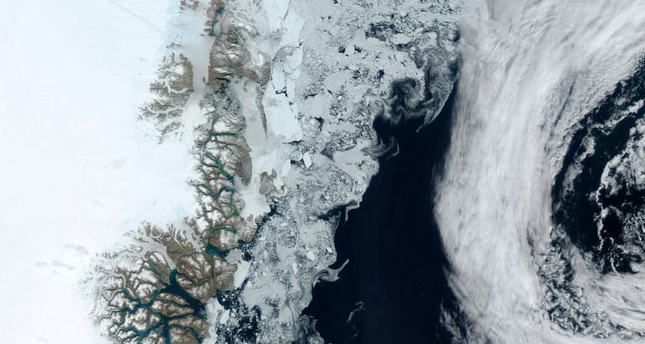Scientists claim that a major glacier in Greenland has begun to crumble into the North Atlantic Ocean. If the glacier melts completely, then there can be a rise in the sea level globally of up to a meter – say scientists.
Monitoring of the huge Zachariae Isstrom glacier in northeast Greenland has revealed that the glacier has started to started to break up into large icebergs where the glacier meets the sea. In 2012, the glacier had rapidly began to melt down. A US team of scientists warned that a rise in sea levels that will continue for decades to come would follow the calving of the glacier into chunks of floating ice that would set into motion the rise in sea level.
“Even if we have some really cool years ahead, we think the glacier is now unstable. Now this has started, it will continue until it retreats to a ridge about 30 km back which could stabilize it and perhaps slow that retreat down,” said Jeremie Mouginot at the University of California, Irvine.
The Zachariae Isstrom glacier’s retreat has been speeding up by 125 meters per year every year until the most recent measurements in 2015. This observation was made based on 40 years of satellite data and aerial surveys by Mouginot and his colleagues who claim that the glacier has began to recede three times faster from 2012.
According to a report in the journal ‘Science’, the area of the glacier’s floating shelf shrank by a massive 95%, based on the same records from 2002 to 2014. The glacier is losing ice at a rate of 4.5 billion tonnes a year as it has now become detached from a stabilizing sill.
The glacier was “being hit from above and below”, with rising air temperatures driving melting at the top of the glacier, and its underside being eroded away by ocean currents that are warmer now than in the past, said Eric Rignot, professor of Earth system science at the University of California, Irvine.
“The glacier is now breaking into bits and pieces and retreating into deeper ground,” he said. This rate of retreat of the glacier is expected to go on for 20 to 30 more years till it reaches another natural ledge that slows it down.
The original position and history of the glacier was recreated by scientists with the help of radar and optical images taken from space as well as from aerial radar, gravitational measurements and laser profiles. The changing shape, size and position of Greenland glaciers over the past four decades was revealed by the combined data from the sources mentioned above.
Scientists are also keeping an eye out for a second enormous glacier in the region just north of Zachariae Isstrom called the Nioghalvfjerdsfjorden. The two glaciers combined drain a region of nearly 200,000 sq km, amounting to 12% of the Greenland ice sheet and scientists fear that if both the glaciers were to melt down to water there would be a rise of a full meter to global sea levels.
(Source:www.theguardian.com)
Monitoring of the huge Zachariae Isstrom glacier in northeast Greenland has revealed that the glacier has started to started to break up into large icebergs where the glacier meets the sea. In 2012, the glacier had rapidly began to melt down. A US team of scientists warned that a rise in sea levels that will continue for decades to come would follow the calving of the glacier into chunks of floating ice that would set into motion the rise in sea level.
“Even if we have some really cool years ahead, we think the glacier is now unstable. Now this has started, it will continue until it retreats to a ridge about 30 km back which could stabilize it and perhaps slow that retreat down,” said Jeremie Mouginot at the University of California, Irvine.
The Zachariae Isstrom glacier’s retreat has been speeding up by 125 meters per year every year until the most recent measurements in 2015. This observation was made based on 40 years of satellite data and aerial surveys by Mouginot and his colleagues who claim that the glacier has began to recede three times faster from 2012.
According to a report in the journal ‘Science’, the area of the glacier’s floating shelf shrank by a massive 95%, based on the same records from 2002 to 2014. The glacier is losing ice at a rate of 4.5 billion tonnes a year as it has now become detached from a stabilizing sill.
The glacier was “being hit from above and below”, with rising air temperatures driving melting at the top of the glacier, and its underside being eroded away by ocean currents that are warmer now than in the past, said Eric Rignot, professor of Earth system science at the University of California, Irvine.
“The glacier is now breaking into bits and pieces and retreating into deeper ground,” he said. This rate of retreat of the glacier is expected to go on for 20 to 30 more years till it reaches another natural ledge that slows it down.
The original position and history of the glacier was recreated by scientists with the help of radar and optical images taken from space as well as from aerial radar, gravitational measurements and laser profiles. The changing shape, size and position of Greenland glaciers over the past four decades was revealed by the combined data from the sources mentioned above.
Scientists are also keeping an eye out for a second enormous glacier in the region just north of Zachariae Isstrom called the Nioghalvfjerdsfjorden. The two glaciers combined drain a region of nearly 200,000 sq km, amounting to 12% of the Greenland ice sheet and scientists fear that if both the glaciers were to melt down to water there would be a rise of a full meter to global sea levels.
(Source:www.theguardian.com)





